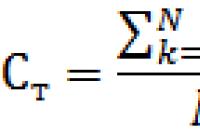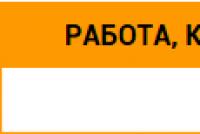Credit card payments. Cashless payment by credit card Bank cards and payments by
FAQ fraudQuestion: When buying goods in a store and paying with a plastic card, I was offered to show my passport as an attachment to a plastic card. Are the requirements of the sellers of the store legitimate, and what legal documents should be referred to in this case, both for me and the seller.
Answer: In the regulations of the Bank of Russia and the Federal laws relating to banking, I have not seen direct instructions for presenting a passport at the time of payment with a bank card when buying goods in a store, however, there are general instructions for identifying their customers by banks, which also relate to this nuance.
The bank card transferred to the client for temporary use belongs to the bank, and settlements with plastic cards during its remote service, as well as identification of the client, the holder of this card, are made on the basis of agreements between:
- bank and cardholder;
- bank and shop.
Identification of the client is carried out if an employee of a trade organization carrying out a transaction with funds suspects that this transaction is carried out in order to legalize (launder) proceeds from crime.
The bank card on which the payment is made may turn out to be stolen or completely fake. A bank plastic card indicates the username (on the front side) and a sample signature (on the back side), but the user presents it or not without verification - it can be impossible to determine, and therefore:
- If there is a photo of the cardholder on the bank card, then the verification of the ownership of the card by the buyer is carried out by simply verifying the photo with the original.
- If the card is without a photo, and the client is suspicious, the cardholder is identified by an identity card. The buyer may be asked to show an identity card (for example, a passport of a citizen of the Russian Federation, a driver's license, a foreign passport or other document), which is carried out on the basis of an agreement between a merchant and a bank in order to secure payments from card accounts.
- Identification of the cardholder by passport may not be carried out if the operation for payment for the goods is carried out at retail outlets with the entry of a security PIN code.
The basis for the requirements of banks to identify the client are the regulations, which I will list below:
- Article 30 of the Federal Law of December 2, 1990 N 395-1 “On Banks and Banking Activities” states that:
"Relations between the Bank of Russia, credit institutions and their clients are carried out on the basis of agreements, unless otherwise provided by federal law"
- On the basis of the Federal Law "On countering the legalization (laundering) of proceeds from crime and the financing of terrorism" (dated 07.08.2001 N 115-FZ), the Regulation of the Bank of Russia dated August 19, 2004 N 262-P "On identification credit institutions of clients and beneficiaries in order to counteract the legalization (laundering) of proceeds from crime and the financing of terrorism ”in the first chapter (clause 1.1) of which it says the following:
“A credit institution is obliged to identify a person who is in its service (hereinafter referred to as the client) when performing banking operations and other transactions in accordance with the Federal Law “On Banks and Banking Activities…”
- Clause 1.4 of the Regulations of the Central Bank of the Russian Federation of December 24, 2004 N 266-P “On the issue of bank cards and on operations performed using payment cards” states:
“On the territory of the Russian Federation, issuing credit institutions issue bank cards, which are a type of payment cards as a cashless payment instrument intended for individuals, including authorized legal entities (hereinafter referred to as holders), to perform operations with funds held by the issuer, in accordance with the legislation of the Russian Federation and the agreement with the issuer"
- Articles 307 - 312 of the Civil Code of the Russian Federation also spell out the concepts and procedure for fulfilling the obligations of the debtor and creditor. Thus, article 309 states the following:
“Obligations must be performed properly in accordance with the terms of the obligation and the requirements of the law, other legal acts, and in the absence of such conditions and requirements, in accordance with the customs of business transactions or other usually imposed requirements”
- Article 3 of the Federal Law "On counteracting the legalization (laundering) of proceeds from crime and the financing of terrorism" (dated August 7, 2001 N 115-FZ) also gives the concept of the word "identification", namely:
"Identification - a set of measures to establish the information specified by this Federal Law about customers, their representatives, beneficiaries, to confirm the reliability of this information using original documents and (or) duly "certified" copies"
In settlements using a payment card, as a rule, the following are involved: the cardholder, the issuing bank and its processing company, a trade and service point with a POS terminal, the acquiring bank and its processing company, the main processing center, the settlement bank in which the bank - the issuer and the acquiring bank have their own correspondent accounts and carry out mutual settlements.
Calculations are carried out as follows: the cashier inserts the card into the slot of the cash terminal, the cardholder's bank account number is reported via the communication channel, the sufficient amount on the account is confirmed (card authorization) and the command is given to write off the money. The card is returned to the owner.
The procedure for making payments using plastic cards is shown in Figure 5.
Figure 5 - Block diagram of a card-based payment system
- - The cardholder opens a special account with the issuing bank; the issuing bank issues a bank card to the cardholder.
- - The cardholder, wishing to receive a product, service or cash, provides a bank card to a POS-terminal or inserts a bank card into an ATM and enters his PIN code.
- - POS-terminal or ATM performs authorization of the card.
- - The ATM writes off the amount of the transaction from the bank card and issues a slip to the cardholder; the cardholder receives goods, services or cash; the bank card is returned to the owner.
- - POS sends slips to the acquiring bank, which serve as a documentary basis for settlements.
- - The acquiring bank makes settlements with the POS for the provided slips, crediting their total amount to the POS account.
- - The acquiring bank sends to the processing center information about the settlements made by it with bank cards.
- - The processing center processes the information received during the day, generates the final data for mutual settlements and communicates them to all participants in the settlements.
- - Participants of settlements carry out the repayment of mutual obligations that arose during transactions using bank cards.
- - The issuing bank debits the amount of the transaction from the special bank account of the cardholder, taking into account the commission
The sale is formalized by issuing sales receipts (slips), which are rolled on special devices. The slip indicates: the name of the cardholder, card number, date of purchase, amount, type of payment system (VISA, Mastercard and others), address of the organization and other information. The slip is filled in with a carbon copy in 3 copies: the first - to the buyer, the second - to the collector, the third - to the accounting department of the organization along with the cash report. The buyer signs in the slip, his signature is verified by the cashier with the signature on the card.
Realization when paying with plastic cards is recorded using cash registers. In light of this, the amounts of cash handed over by the cashier at the end of the day do not match the meter readings for the amount of proceeds from the sale using plastic cards.
Cash deposit can be made to a card, the account of which is opened in US dollars or euros - by the main holder using the card; to a card whose account is opened in Russian rubles - using the main or additional card, as well as by any individual without presenting a card (by its number). It is not allowed to carry out "Cash deposit" operations on cards issued by third-party banks. When carrying out the "Cash deposit" operation, a commission is charged in accordance with the bank's tariffs.
Replenishment of the account by depositing cash at the cash desks of the bank is carried out only upon presentation of an identity document.
Account replenishment methods:
- - depositing cash in the bank division at the place of application for a card or in any division of the given branch of the bank if there is a remote access to the centralized database of individuals' accounts in the bank branch;
- - by bank transfer from accounts, deposits maintained in the same division of the bank;
- - transfer from other departments of the bank and other credit organizations;
- - accrual of interest in accordance with the tariffs of the bank.
Funds are transferred from card to card in three types of currencies, regardless of the currency of the card account: in Russian rubles, US dollars and euros. It is not allowed to transfer funds through the cash desks of the bank using cards issued by third-party banks. If the recipient's card account is opened in a foreign currency, and the sender's and recipient's cards belong to different individuals, the client will be denied the operation.
There are 3 main methods for making payments on the Internet using a plastic card. The first way is to register your online store in the so-called virtual terminal. This process involves manually entering information about the plastic card into a secure terminal immediately after receiving the order.
The second solution involves creating a redirection of the buyer from your site to a separate service for making a payment. Already on the site of a third-party service, the user enters the data of a plastic card in order to make a payment. As soon as the transaction is completed, the buyer is again transferred to the pages of your online store.
The best method of accepting payments is the method when you open a seller (merchant) account and accept payment through the gateway directly on the pages of your online store.
All systems for receiving money from buyers have a single principle of operation:
- - The user enters the necessary data in a certain form;
- - The buyer, after filling out the form, gets to the payment page in the selected electronic payment system;
- - The owner of the goods receives a letter from the partner with payment data and checks the correctness of the payment amount;
- - The buyer is redirected to the file download page or receives a password to access private pages or files. If this is an online store, the buyer receives an email with a notification that his order has been accepted.
Currently, more and more transactions are carried out by customers without visiting the bank. Modernization of telecommunication systems used for remote servicing of banking clients has led to the emergence of a new concept for organizing banking activities. Creation of self-service zones allows to drastically reduce the load on the bank's operating room specialists and, accordingly, reduce the number of executors. Fully automated branches are also being created, which are premises equipped with special banking equipment. They can be located in residential buildings, on the territory of shops, industrial facilities, stations, etc. and provide services in automatic mode 24 hours a day.
Bank plastic cards issued by banks are a convenient form of non-cash payments. Such settlements on the territory of the Russian Federation are regulated by the Regulation of the Central Bank of the Russian Federation dated April 9, 1998 “On the procedure for issuing bank cards by credit institutions and making settlements for transactions made using them” Regulation of the Central Bank of the Russian Federation dated April 9, 1998 No. 23-P “Regulations on the Procedure for Issuing Bank Cards by Credit Institutions and Making Settlements for Operations Made with Their Use” // Bulletin of the Bank of Russia, No. 23, 15.04.98.
A credit institution is entitled to issue bank cards of other credit institutions - issuers and payment cards of issuers - foreign legal entities that are not foreign banks on the territory of the Russian Federation (hereinafter referred to as distribution of payment cards).
Specific conditions for the provision of funds for settlements on transactions made using settlement (debit) cards, credit cards, the procedure for the return of funds provided, the procedure for documentary confirmation of the provision and return of funds, as well as the accrual and payment of interest on the specified funds may be determined in agreement with the client.
The provision by a credit institution of funds to customers for settlements on transactions made using credit cards is carried out by crediting the specified funds to their bank accounts or without using the client's bank account, if this is provided for by the loan agreement when providing funds in the currency of the Russian Federation to individuals - residents.
Documentary confirmation of the provision of a loan without using the client's bank account is the register of payments received by the credit institution, unless otherwise provided by the loan agreement. Fulfillment of obligations to return the provided funds and pay interest on them is carried out by clients in a non-cash manner by debiting or transferring the specified funds and interest on them from bank accounts of clients opened with a credit organization - issuer or other credit organization, as well as in cash through the cash desk , ATM - customers - individuals.
On the territory of the Russian Federation, credit institutions (hereinafter - credit institutions - acquirers) carry out settlements with organizations of trade (services) on transactions performed using payment cards, and (or) issue cash to holders of payment cards that are not clients of these credit institutions ( hereinafter - acquiring).
A credit institution may simultaneously issue bank cards, acquire payment cards, and distribute payment cards. Issue of bank cards, acquiring of payment cards, as well as distribution of payment cards is carried out by credit institutions on the basis of internal banking rules developed by the credit institution in accordance with the legislation of the Russian Federation, including this Regulation, other regulatory acts of the Bank of Russia, and the rules of participants in settlements containing them. rights, obligations and procedure for settlements between them.
The number of credit institutions involved in the issuance or acquiring of bank cards is 718;
Number of credit institutions-issuers - 674;
The number of credit organizations-acquirers is 642.
When making transactions using a payment card, a credit institution is obliged to identify its holder in accordance with paragraph 1 of Article 7 of the Federal Law "On counteracting the legalization (laundering) of proceeds from crime and the financing of terrorism" in the manner established by the Regulation of the Bank of Russia dated August 19, 2004 of the year N 262-P "On the identification by credit institutions of clients and beneficiaries in order to counteract the legalization (laundering) of proceeds from crime and the financing of terrorism", registered by the Ministry of Justice of the Russian Federation on September 6, 2004 No. 6005.
Operations can be performed on one client account using several payment (debit) cards, credit cards issued by a credit institution - issuer to the client (a person authorized by the client).
Transactions can be performed on several customer accounts using one settlement (debit) card or credit card issued by the credit institution - issuer to the customer (person authorized by the customer).
The client - an individual performs the following operations using a bank card: Regulations on the issue of bank cards and on operations performed using payment cards, approved by the Central Bank of the Russian Federation of December 24, 2004 No. 266-P (as amended by the Instruction of the Central Bank of the Russian Federation of September 21. 2006 No. 1725-U)
Receipt of cash in the currency of the Russian Federation or foreign currency on the territory of the Russian Federation;
Receipt of cash in foreign currency outside the territory of the Russian Federation;
Payment for goods (works, services, results of intellectual activity) in the currency of the Russian Federation on the territory of the Russian Federation, as well as in foreign currency - outside the territory of the Russian Federation;
Other transactions in the currency of the Russian Federation, in respect of which the legislation of the Russian Federation does not establish a ban (restriction) on their performance;
Other transactions in foreign currency in compliance with the requirements of the currency legislation of the Russian Federation.
A client - an individual can carry out, using settlement (debit) cards, credit cards, the operations specified in this clause on bank accounts opened in the currency of the Russian Federation, and (or) on bank accounts opened in foreign currency.
When issuing settlement (debit) cards, credit cards, credit organizations may provide in the bank account agreement, loan agreement a condition for the client to carry out transactions using these cards, the amount of which exceeds:
The balance of funds on the client's bank account in case the conditions for granting an overdraft are not included in the bank account agreement;
Overdraft limit;
The credit limit specified in the loan agreement.
Settlements for the said transactions may be carried out by granting a loan to the client in the manner and on the terms stipulated by the bank account agreement or the loan agreement. When performing a transaction using a payment card, documents are drawn up on paper and (or) in electronic form (hereinafter referred to as the document on transactions using a payment card). The document on transactions using a payment card is the basis for making settlements on the specified transactions and (or) serves as confirmation of their completion.
Consider the procedure for obtaining a bank card and conducting transactions using it.
In order to become the owner of a bank card, a legal or natural person must open a special bank account with the issuing bank by concluding an appropriate bank account agreement (agreement for settlement and cash services), a bank deposit agreement, a loan or other agreement providing for transactions using bank accounts. kart. In this case, the issuing bank issues a bank card to the owner, who receives the right to use it, the card itself remains the property of the bank.
Each card must contain the name and logo of the issuing bank, which allow it to be uniquely identified. In addition, each card is assigned a PIN code - a personal identification number that provides the cardholder with the opportunity to service at ATMs or POS.
The procedure for making payments using plastic cards can be represented as a diagram (see Fig. 1).
Rice. one
1. The cardholder opens a special account with the issuing bank; the issuing bank issues a bank card to the cardholder.
2. The cardholder, wishing to receive a product, service or cash, provides a bank card to a POS-terminal or inserts a bank card into an ATM and enters his PIN code.
3. POS-terminal or ATM authorizes the card.
4. The ATM deducts the amount of the transaction from the bank card and issues a slip to the cardholder (which, as a rule, he must sign); the cardholder receives goods, services or cash; the bank card is returned to the owner.
5. POS sends slips to the acquiring bank, which serve as a documentary basis for settlements.
6. The acquiring bank makes settlements with the POS for the provided slips, crediting their total amount to the POS account.
7. The acquiring bank sends to the processing center information about the settlements made by it with bank cards.
8. The processing center processes the information received during the day, generates the final data for mutual settlements and communicates them to all participants in the settlements.
9. Settlement participants shall repay mutual obligations that have arisen in the course of transactions using bank cards.
10. The issuing bank debits the amount of the transaction from the special bank account of the cardholder, taking into account the commission
Depending on the payment technology, cards are divided into slip and smart cards. The slip-card has a magnetic strip containing information about the details of the card account opened with the bank when purchasing the card. When paying for a purchase using a special terminal, the seller of goods and services reads this information from the card and carries out authorization, that is, through a special communication line, it connects to the pressing center, where information about the state of the client's card account is stored, and finds out if the client can pay for the purchase. Information about the purchase is recorded on a slip-card print, which is forwarded to the payment center or bank. The slip card contains the customer's order to transfer money for the purchase from a special card account to the seller's account.
A smart card has a built-in microprocessor - a chip. In the bank, a certain amount is debited from the special card account of the client into the memory of the smart card, as a result of which the smart card becomes, as it were, an electronic wallet. When making a purchase, the cardholder, when making a payment, inserts it into a special cash terminal equipped with a reader and dials his personal password (pin-code). The merchant, using a reader, checks the authenticity of the card, and then debits the card (writes off the required amount) and credits the POS terminal (credits the amount debited from the card) connected to the bank. If the cardholder does not have enough amounts stored in the card memory, he can supplement his “electronic wallet” with the missing amount in a non-cash form at the branch of the bank included in this payment card system.
Depending on who the cards will be sold to, they can be Money, credit, banks. Textbook / Ed. E.F. Zhukov. - M.: UNITI, 2003:
Individual (own), when one card account corresponds to one card;
Family, when members of the same family - owners of several cards - use one card account;
Corporate - for legal entities with the appointment of an authorized representative or several authorized representatives who will manage the account within the personal limit or without it with a single or several cards.
Settlement and cash services for customers on transactions using bank cards issued to them can only be carried out by the credit institution whose logo and (or) name is present on the front side of these cards. The presence of logos of other credit institutions is not allowed.
A corporate credit card is a bank card that allows the holder, authorized by a legal entity, to carry out transactions in the amount of the credit line provided by the issuer and within the spending limit set by the issuer in accordance with the terms of the agreement with the client, according to the list of permitted transactions.
To obtain a corporate bank card, an organization must open an account with the issuing bank and conclude an agreement that would provide for settlements on the account using a bank card.
The most popular among plastic card users in the Russian Federation are international plastic cards ViSa (40%) and Europay (25%), which are accepted worldwide in more than 120 countries (see Fig. 2).
plastic card settlement payment
All settlements on transactions using bank cards made on the territory of the Russian Federation are carried out only in the currency of the Russian Federation - rubles on the basis of an agreement concluded between the bank and the counterparty (individual or legal entity). An exception is payments in foreign currency, provided for by the current legislation of Russia. The name and logo of the issuer must be present on the bank card, uniquely identifying it.

A bank card is an electronic settlement document of the established form, made in plastic, with the help of which the cardholder or a person authorized by him instructs the bank - card issuer to transfer, credit and withdraw funds from the corresponding account.
The use of bank cards in non-cash payments allows you to achieve certain benefits and conveniences at the state level, bank card holders, credit organizations, trading organizations.
The public benefits include:
1. Reducing the cash flow and, accordingly, the costs of its maintenance, as well as the "nutrient environment" for theft, offenses, tax evasion,
2. Reduction in the number of employed persons in the field of cash circulation and their release for productive labor,
3. Accelerating the turnover of funds in the national economy,
4. Reducing the amount of non-payments on the obligations of all economic entities,
5. Reducing the workflow, especially on paper,
6. In connection with the acceleration of the turnover of funds, their mass is reduced, which is necessary for mediating the turnover of goods, which is especially important in conditions of inflation, when the real money supply is reduced.
For cardholders, their use provides the following advantages compared to cash payments:
1. The risk of losing money is reduced,
2. The risk of traditional forms of theft is eliminated,
3. It is possible to receive income in the amount of a set percentage from the balance of funds on the card account,
4. Benefits (discounts) are possible when purchasing goods and services,
5. It is possible to reduce costs when performing financial transactions (currency conversion, transfer of funds),
6. The ability to quickly pay for the purchase without having cash,
7. Kudos,
8. Some cardholders may receive benefits such as exchanging purchased items, booking hotel rooms, purchasing airline tickets, etc.
However, card payments are not without some disadvantages:
1. Services of banks for issuing and servicing cards are paid,
2. Bank cards are not accepted in all stores and service companies,
3. Timeliness of payments and safety of funds on card accounts depends on the liquidity of the bank.
For credit institutions, the issue of bank cards leads to positive results:
1. The resource base of banks is expanding due to the growth of balances on card accounts,
2. A new source of income appears in the form of fees for servicing the cardholder (the cost of the card, transfer of funds, cashing out, conversion, etc.),
3. The issuance of consumer loans when issuing credit cards and, accordingly, the income from credit operations increases,
4. Increasing the competitiveness of the bank in the banking services market in the region,
5. When issuing international bank cards, the international rating of the bank grows.
At the same time, the issuance of bank cards requires large expenses from the bank, which, in the absence of a culture of using bank cards, an underdeveloped infrastructure, makes bank investments risky. The risks associated with the theft of cards, fake cards can also be significant.
The use of bank cards by trade and services can bring positive results in the form of:
1. Expansion of trade by attracting new customers who prefer to pay by cards,
2. Reducing the cost of servicing the cash flow: the cost of collection, the protection of cash at the box office, etc.
3. Elimination of the risk of theft of cash from the cash desk of the enterprise,
4. Acceleration of cash turnover of a trading company.
Thus, a bank card, performing its functions, can help improve the structure of the money supply, promote the promotion of goods to the consumer, expand the revenue base of banks and trading organizations, improve the culture of service and create convenience for the population.
Russian payment systems issue personal (for individuals) and corporate (for legal entities) cards.
According to the type of settlements, the following types of payment cards are distinguished:
1. Payment card- a bank card issued to the owner of funds on a bank account, the use of which allows its holder, in accordance with the terms of the agreement between the card issuer (bank) and the client, to dispose of the funds on his account to pay for goods and services, receive cash.
2. Credit card- a bank card, the use of which allows its holder, in accordance with the terms of the agreement with the card issuer, to carry out transactions in the amount of the credit line provided by the issuer and within the spending limit established by the issuer for paying for goods and services, receiving cash.
Depending on the type of card, the cost of the card, the amount of the initial payment and the size of the minimum balance on the card account, the cost of annual maintenance, etc. are set. Moreover, the tariffs for cards of even one payment system are different for different issuers and periodically change depending on the state of the money market. Most of the issuing banks for issuing cards do not require an initial payment and a minimum balance on the card account. Issuers of Russian bank cards do not set a payment limit for a certain period (week, month). The account holder spends funds with the card within the balance of the account, as needed. For the issuance of cash on the card, a commission is charged from 0 to 1%% of the amount.






